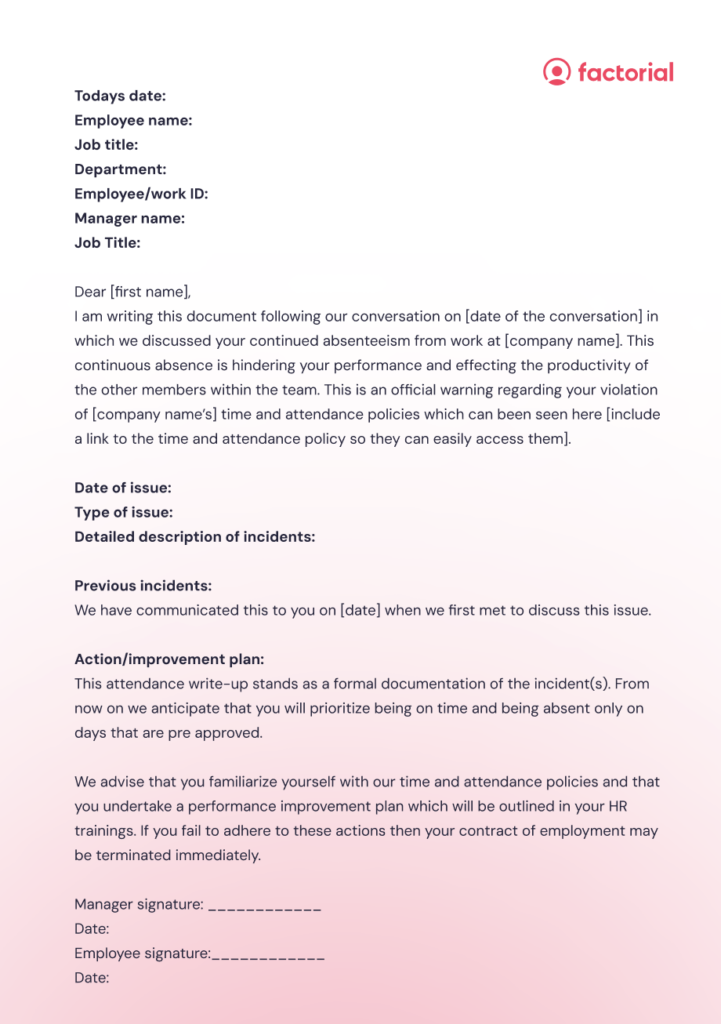Throughout this article, we will explore what an attendance write-up is, the purpose of implementing one, a sample example, and top tips to follow. By fully understanding the importance of an attendance write-up, companies can proactively deal with attendance issues and the effect it has on the productivity, motivation, and performance of other team members.
Download our free Attendance Write-Up PDF to handle attendance issues professionally. 
Factorial’s your all-in-one Business Management Software that empowers your team & boosts efficiency.👆
What is an attendance write-up?
Anyone could be late for work occasionally due to issues outside of their control such as traffic, family, or illness but when it is reoccurring it is crucial for managers to address their employees. This document acts as a formal disciplinary documentation that addresses and solves instances of poor attendance at work. Attendance write-ups are really important for managing your employees overall performance. Employee attendance is crucial for maintaining high productivity and motivation levels. An attendance write-up is needed when an employee is having poor attendance and a verbal warning did not work.
Absenteeism has a financial and operational impact on companies as productivity, morale and engagement are all effected. Forbes states that businesses lose $225.8 billon annually to absences at work and that each workers absence creates a yearly cost of $1,685. This study also shows how unplanned absences can lead to approximately 36% dip in productivity.
An example of an attendance write-up

What is the purpose of an attendance write-up?
Attendance write-ups are a useful tool for managers to deal with reoccurring issues linked to attendance performance. The purpose of an attendance write-up is to formally inform the employee of the severity of the issue via documentation and communication. This also protects the company from any legal issues that could arise as it clearly documents the process that the employee in question ignored.
You should use an attendance write-up in situations where an employee’s attendance does not meet the expected standards. This could also mean that they are violating company policies such as attendance policies. It is crucial that when conducting an attendance write-up the company must be consistent, honest and in compliance with labor laws such as the Family and Medical Leave Act. Are you familiar with other US labor laws around time and attendance? Why not take a look at our article on time and attendance in the US.
When to use an attendance write-up?
Consistently late
When an employee is regularly late for work without a valid reason that is out of their control.
Excessively absent
When an employee regularly does not show up for work and it is a pattern. This includes no shows, no notice and unscheduled or unapproved absences.
Violation of company policy
This may include the employee failing to request time off from their manager, not letting managers know that they will not be coming to work and abusing paid or illness leave policies.
What should you include in an attendance write up?
When creating an attendance write-up it is very important to gather the correct data and ensure that everything listed is clear and easy to follow.
- Date of the write up: Include the date that you document that attendance performance issue.
- Employee data: Include the person in questions full name, job title, job department, work ID number and any other relevant personal details.
- Manager information: The manager who is writing the report must state their full name and job title.
- Absence dates and times: Specify the specific dates and times that this employee was late or absent.
- Type of absence issue: Portray if the issue is absenteeism, tardiness or leaving early.
- Description: Portray a clear and honest description of the issue that you have been facing. It is crucial that you stick to factual information and limit opinion based descriptions. Include any relevant background information.
- Previous issues: Explain how the employee’s actions have violated the attendance policy at your company. Record any previous attendance related issues that the employee did (ensuring to include dates and times).
- Impact statement: Include a description about the impact of the employees actions. This can include but is not limited to the impact on the wider team such as a dip in productivity, feelings of overwhelm due to additional burden and missed deadlines in team projects.
- Action plan: Explain next steps that the employee must follow in order to solve the issue. This could involve a meeting with someone like a director or senior member of staff, training around time off approval or a performance improvement plan (PIP). It is important to clearly state the consequences of continuing to violate the attendance policy which can include a disciplinary action or termination of the employment contract.
- Signature: Ensure there is a section of the document that allows the employee to acknowledge the attendance write-up by signing their name and adding the date.
Sample of an attendance write up
Todays date:
Employee name:
Job title:
Department:
Employee/work ID:
Manager name:
Job Title:
Dear [first name],
I am writing this document following our conversation on [date of the conversation] in which we discussed your continued absenteeism from work at [company name]. This continuous absence is hindering your performance and effecting the productivity of the other members within the team. This is an official warning regarding your violation of [company name’s] time and attendance policies which can been seen here [include a link to the time and attendance policy so they can easily access them].
Date of issue:
Type of issue:
Detailed description of incidents:
Previous incidents:
We have communicated this to you on [date] when we first met to discuss this issue.
Action/improvement plan:
This attendance write-up stands as a formal documentation of the incident(s). From now on we anticipate that you will prioritize being on time and being absent only on days that are pre approved.
We advise that you familiarize yourself with our time and attendance policies and that you undertake a performance improvement plan which will be outlined in your HR trainings. If you fail to adhere to these actions then your contract of employment may be terminated immediately.
Manager signature: ____________
Date:
Employee signature:____________
Date:
10 tips for giving written warnings to an employee
- Be clear and honest when documenting any information about an incident.
- Ensure that you act fast in order to prevent problems in escalating.
- Note any relevant company policies and standards that have been violated.
- Use factual language. Avoid opinion based arguments or ambiguity.
- Keep privacy and confidentiality as a priority. Deliver the letter in private and avoid drawing attention to the matter.
- Provide a clear action plan for the employee to follow.
- Ensure that you prepare thoroughly and include all relevant documents or links to support your official warning.
- Plan a follow-up meeting to review the employees progress. This portrays a commitment to their development and strong leadership skills.
- Seek advice from the HR team at your company if you are unsure about anything.
- Having a well designed time off tracking technology can help eliminate having to give attendance write-ups altogether! This software will assist HR teams, managers and the company overall to lower absenteeism rates. Why not try out Factorial and book your demo below!
Benefits of using Time Tracking Software
Absence management along with many of the HR functions are tough tasks to manage without the proper tools and resources. Time tracking is a continuous process and one that needs to be managed regularly. Factorial’s time and attendance software has a myriad of benefits including tracking clocking in and out, exporting detailed timesheets, managing overtime requests, creating paid and unpaid breaks and addressing time tracking inconsistencies along with many more features. Check out how Factorial can solve your time management paint points by booking a call with our HR product experts. They will bring tailored solutions to you and your team to help eliminate your repetitive, manual work, including:
✅ Syncing employee timesheets with payroll
✅ Geolocation & biometric time tracking options
✅ Associating logged hours with projects


